Thursday, December 31, 2009
HAPPY NEW YEAR 2010
Monday, December 28, 2009
The Toothless Cat Art Show- Philadelphia
Sunday, December 27, 2009
Bohemian Carnival for New Year's Eve
Saturday, December 26, 2009
Thursday, December 24, 2009
The Scold's Bridle
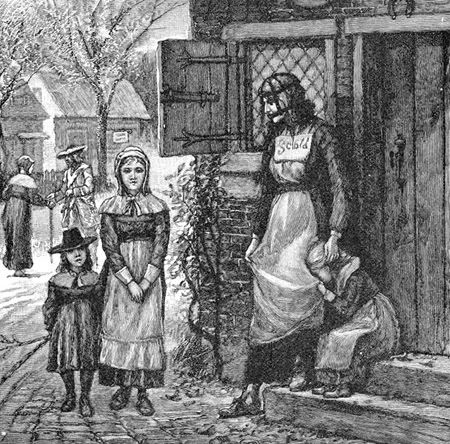
First used in late medieval Scotland, the scold's bridle, witch's bridle, or brank, as it was sometimes called, had many different appearances. Fundamentally, it was the same: a metal cage for the head with a built-in gag. Some branks were very cruel pieces of work, with spikes which pierced the tongue. Some simply had a bell built in, a device which would further humiliate the "scold" who wore it through the streets.
In the streets, the scold would be subjected to the taunting and jeering of the crowds which gathered to witness the spectacle.
HAPPY HOLIDAYS!!!
Wednesday, December 23, 2009
Iceberg Stripes



 Icebergs in the Antarctic area sometimes have stripes, formed by layers of snow that react to different conditions.
Icebergs in the Antarctic area sometimes have stripes, formed by layers of snow that react to different conditions.Blue stripes are often created when a crevice in the ice sheet fills up with melt water and freezes so quickly that no bubbles form.
When an iceberg falls into the sea, a layer of salty seawater can freeze to the underside. If this is rich in algae, it can form a green stripe.
Brown, black and yellow lines are caused by sediment, picked up when the ice sheet grinds downhill towards the sea.
Medieval Torture
Coffin Torture

.
The period of time a victim was to be kept inside the coffin was determined by his or her crime. Very serious crimes, such as blasphemy, were punished by death inside the coffin where the victim was to be kept inside under the sun with animals eating his or her flesh.
The coffin was sometimes placed in a public plaza so the local population would congregate around it and mock the unlucky victim. Sometimes death occurred because of the hatred towards the person as others often threw rocks and other objects to further increase the pain.
The Witch's chair
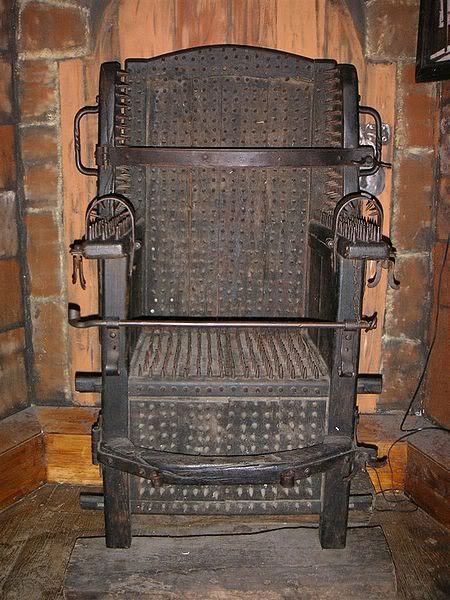
There are many variants of the chair. They all have one thing in common: spikes cover the back, arm-rests, seat, leg-rests and foot-rests. The number of spikes in one of these chairs ranges from 500 to 1,500.
To avoid movement, the victim's wrists were tied to the chair or, in one version, two bars pushed the arms against arm-rests for the spikes to penetrate the flesh even further. In some versions, there were holes under the chair's bottom where the torturer placed coal to cause severe burns while the victim still remained conscious.
This instrument's strength lies primarily in the psychological fear caused on the victims. It was a common practice to extract a confession by forcing the victim to watch someone else be tortured with this instrument.
The time of death greatly varied ranging from a few hours to a day or more. No spike penetrated any vital organ and the wound was closed by the spike itself which delayed blood loss greatly.
The heretics fork
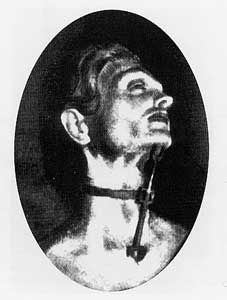
The heretics fork was used in the Middles Ages mainly during the Spanish Inquisition
The instrument consists of two forks set against each other that penetrated the flesh under the chin in one end and the upper chest in the other. As usual, this instrument didn't harm any vital points; thus avoiding death and prolonging pain.
The victim's hands were tied behind his back to prevent any chance of escape. The Heretics Fork made speech and neck movement almost impossible and was used after a confession to avoid hearing the victim any further. As can be seen in the picture, a small collar supported the fork forcing the victim to hold his head erect.
Sometimes the victim was incarcerated and subject to this instrument as well. This instrument often harmed the neck of the victim, as well as potentially spreading an infection or disease.
Exposure
As its name implies, this method consists of exposing a victim to the elements. The victim could be buried up to his neck letting any animals, insects or other people kill him slowly.
In some towns there were chains, stocks or ropes used to quickly restrain someone. In many cases, the victim was simply left to die of hunger and thirst.
Due to its cost efficiency and cruelty, the exposure torture was very widespread in medieval Europe. The victim's remains often served as a warning to the population.
In many cases, the victim was sentenced to a short period of exposure, depending on the crime. However, death was frequent since they were completely defenseless.
The Pillory Torture
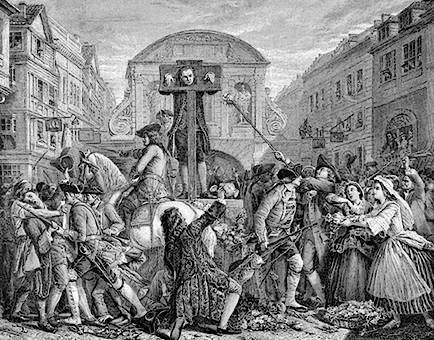
The pillory was used to publicly humiliate a victim. Even though it was meant as a mild form of punishment, the crowd sometimes made it lethal.
The pillory often served as a post for flagellation. When the victim was restrained with the device, he was completely defenseless and subject to the crowd.
In many cases the crowd threw harmless objects such as vegetables, but when the victim committed a serious offense they threw stones or other heavy objects. The crowd often humiliated the victim by cutting his hair, putting marks on his body and even mutilating some of his body parts.
The pillory didn't last more than a few hours, but it was sometimes carried on for days. The device was situated in either the marketplace or the plaza - where most villagers could see the victim's suffering. The army was also well-known for using the pillory as a means of punishment.
Happy Holidays!
Monday, December 21, 2009
Winter Solstice

The Winter Solstice, also known as Midwinter, occurs around December 21 or 22 each year in the Northern hemisphere, and June 20 or 21 in the Southern Hemisphere. It occurs on the shortest day or longest night of the year, often said to mark the beginning of a hemisphere's astronomical winter. The word solstice derives from Latin, Winter Solstice meaning Sun set still in winter. Worldwide, interpretation of the event varies from culture to culture, but most hold a recognition of rebirth, involving festivals, gatherings, rituals or other celebrations. Many cultures celebrate or celebrated a holiday near the winter solstice; examples of these include Christmas, Hanukkah, Kwanzaa, New Years, Pongal and many other festivals of light. Depending on the shift of the calendar the event of the Winter solstice, occurs sometime between December 20 and 23 each year in the northern hemisphere, and between June 20 and 23 in the Southern Hemisphere, within either the shortest day or the longest night of the year, when the sun is at its greatest distance opposite the equatorial plane relative a polar hemisphere.

The solstice itself may have remained a special moment of the annual cycle of the year since neolithic times. This is attested by physical remains in the layouts of late Neolithic and Bronze Age archeological sites like Stonehenge and New Grange in the British Isles. The primary axes of both of these monuments seem to have been carefully aligned on a sight-line framing the winter solstice sunrise (New Grange)and the winter solstice sunset (Stonehenge). The winter solstice may have been immensely important because communities were not assured to live through the winter, and had to be prepared during the previous nine months. Starvation was common in winter between January to April, also known as the famine months. In temperate climes, the midwinter festival was the last feast celebration, before deep winter began. Most cattle were slaughtered so they would not have to be fed during the winter, so it was nearly the only time of year when a supply of fresh meat was available. The majority of wine and beer made during the year was finally fermented and ready for drinking at this time.

Christmas History
Christmas is an annual holiday that celebrates the birth of Jesus. Christmas festivities often combine the commemoration of Jesus' birth with various secular customs, many of which have been influenced by earlier winter festivals, such as discussed above. The date of the celebration is traditional but it is not considered to be his actual date of birth.
A winter festival was traditionally the most popular festival of the year in many cultures. Reasons included less agricultural work needing to be done during the winter, as well as people expecting longer days and shorter nights after the winter solstice in the Northern Hemisphere. In part, the Christmas celebration was created by the early Church in order to entice pagan Romans to convert to Christianity without losing their own winter celebrations. Most of the most important gods in the religions of Ishtar and Mithra had their birthdays on December 25.

Various traditions are considered to have been syncretised from winter festivals including the following: In Roman times, the best-known winter festival was Saturnalia, which was popular throughout Italy. Saturnalia was a time of general relaxation, feasting, merry-making, and a cessation of formal rules. It included the making and giving of small presents (Saturnalia et Sigillaricia), including small dolls for children and candles for adults. During Saturnalia, business was postponed and even slaves feasted. There was drinking, gambling, and singing, and even public nudity. It was the "best of days," according to the poet Catullus. Saturnalia honored the god Saturn and began on December 17. The festival gradually lengthened until the late Republican period, when it was seven days (December 17-24). In imperial times, Saturnalia was shortened to five days.

he Romans held a festival on December 25 called Dies Natalis Solis Invicti, "the birthday of the unconquered sun." The use of the title Sol Invictus allowed several solar deities to be worshipped collectively, including Elah-Gabal, a Syrian sun god; Sol, the god of Emperor Aurelian (AD 270-274); and Mithras, a soldiers' god of Persian origin. Emperor Elagabalus (218-222) introduced the festival, and it reached the height of its popularity under Aurelian, who promoted it as an empire-wide holiday.
December 25 was also considered to be the date of the winter solstice, which the Romans called bruma. It was therefore the day the Sun proved itself to be "unconquered" despite the shortening of daylight hours. (When Julius Caesar introduced the Julian Calendar in 45 BC, December 25 was approximately the date of the solstice. In modern times, the solstice falls on December 21 or 22.) The Sol Invictus festival has a "strong claim on the responsibility" for the date of Christmas, according to the Catholic Encyclopedia. Several early Christian writers connected the rebirth of the sun to the birth of Jesus (sun/Son). "O, how wonderfully acted Providence that on that day on which that Sun was born . . . Christ should be born," Cyprian wrote.
In most places around the world, Christmas Day is celebrated on December 25. Christmas Eve is the preceding day, December 24. In the United Kingdom and many countries of the Commonwealth, Boxing Day is the following day, December 26. In Catholic countries, Saint Stephen's Day or the Feast of St. Stephen is December 26. The Armenian Apostolic Church observes Christmas on January 6. Eastern Orthodox Churches that still use the Julian Calendar celebrate Christmas on the Julian version of 25 December, which is January 7 on the more widely used Gregorian calendar, because the two calendars are now 13 days apart. (Armenians who use the Julian Calendar celebrate Christmas on the Julian version of Jan. 6, which is Jan. 19 on the Gregorian calendar.)

Pagan Scandinavia celebrated a winter festival called Yule, held in the late December to early January period. Yule logs were lit to honor Thor, the god of thunder, with the belief that each spark from the fire represented a new pig or calf that would be born during the coming year. Feasting would continue until the log burned out, which could take as many as twelve days.In pagan Germania (not to be confused with Germany), the equivalent holiday was the mid-winter night which was followed by 12 "wild nights", filled with eating, drinking and partying. As Northern Europe was the last part to Christianize, its pagan celebrations had a major influence on Christmas. Scandinavians still call Christmas Jul. In English, the Germanic word Yule is synonymous with Christmas, a usage first recorded in 900.
The word "Christmas" is a contraction of two words "Christ's mass" and is derived from the Middle English Christemasse and Old English Cristes mæsse, a phrase first recorded in 1038. In early Greek versions of the New Testament, the letter Χ (chi), is the first letter of Christ (Χριστός). Since the mid-16th century Χ, or the similar Roman letter X, was used as an abbreviation for Christ. Thus, Xmas is an abbreviation for Christmas.
After the conversion of Anglo-Saxons in England from their indigenous Anglo-Saxon polytheism (a form of Germanic paganism) in the very early 7th century, Christmas was called geol, which was the name of the native Germanic pre-Christian solstice festival that fell on that date. From geol, the current English word Yule is derived. Many customs associated with modern Christmas were derived from Germanic paganism.
The prominence of Christmas Day increased gradually after Charlemagne was crowned on Christmas Day in 800. Around the 12th century, the remnants of the former Saturnalian traditions of the Romans were transferred to the Twelve Days of Christmas (26 December - 6 January). Christmas during the Middle Ages was a public festival, incorporating ivy, holly, and other evergreens, as well as gift-giving.
Modern traditions have come to include the display of Nativity scenes, Holly and Christmas trees, the exchange of gifts and cards, and the arrival of Father Christmas or Santa Claus on Christmas Eve or Christmas morning. Popular Christmas themes include the promotion of goodwill and peace.(wikihistory)

Wednesday, December 16, 2009
Aokigahara- The Suicide Forest
Tuesday, December 15, 2009
The Hellfire Club
Thursday, December 10, 2009
Gorehounds, Take Heed...
Once in a blue moon
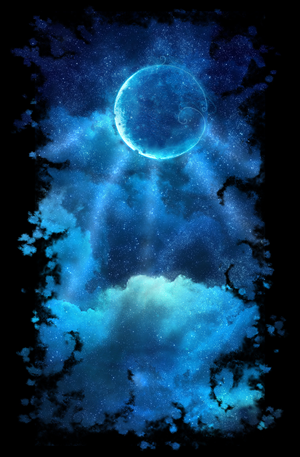
What is a Blue Moon?
There are in fact two definitions for a blue moon. According to the more recent definition, a blue moon is the second full moon in a calendar month. For a blue moon to occur, the first of the full moons must appear at or near the beginning of the month so that the second will fall within the same month (the average span between two moons is 29.5 days).
The Other Kind of Blue Moon
May 2008's blue moon qualified as such under an older definition, which is recorded in early issues of the Maine Farmer's Almanac. According to this definition, the blue moon is the third full moon in a season that has four full moons. Why would one want to identify the third full moon in a season of four full moons? The answer is complex, and has to do with the Christian ecclesiastical calendar.
Some years have an extra full moon—13 instead of 12. Since the identity of the moons was important in the ecclesiastical calendar (the Paschal Moon, for example, used to be crucial for determining the date of Easter), a year with a thirteenth moon skewed the calendar, since there were names for only 12 moons. By identifying the extra, thirteenth moon as a blue moon, the ecclesiastical calendar was able to stay on track.
How Often Does a Blue Moon Occur?
Over the next 20 years there will be about 15 blue moons, with an almost equal number of both types of blue moons occurring. No blue moon of any kind will occur in the years 2011, 2014, and 2017.
The more recent phenomenon, where the blue moon is considered to be the second full moon in a calendar month, last occurred on May 31, 2007. Two full moons in one month may occur in any month out of the year except for February, which is shorter than the lunar cycle.
The other, older blue moon event, which happens when there are four full moons in a season, last occurred in August 2005. Since this type of blue moon is reckoned according to the seasons, it can only occur in February, May, August, or November, about a month before the equinox or the solstice.
Twice in a Blue Moon
The rare phenomenon of two blue moons (using the more recent definition) occurring in the same year happens approximately once every 19 years. 1999 was the last time a blue moon appeared twice, in January and March.
The months of the double blue moons are almost always January and March. That is because the short month that falls in between them, February, is a key ingredient in this once-every-19-year phenomenon. For January and March to each have two full moons, it's necessary for February to have none at all. Since February is usually 28 days long, and the average span between full moons is 29.5 days, if a full moon occurs at the end of January, it's possible for the next full moon to skip February entirely and fall in the beginning of March.
Once in a Blue Moon
"Blue moon" appears to have been a colloquial expression long before it developed its calendrical senses. According to the Oxford English Dictionary, the first reference to a blue moon comes from a proverb recorded in 1528:
If they say the moon is blue,Saying the moon was blue was equivalent to saying the moon was made of green (or cream) cheese; it indicated an obvious absurdity. In the 19th century, the phrase until a blue moon developed, meaning "never." The phrase, once in a blue moon today has come to mean "every now and then" or "rarely"—whether it gained that meaning through association with the lunar event remains uncertain
We must believe that it is true.
Next blue moon? December 31 2009
Happy Holidays!
Wednesday, December 9, 2009
Artist Kitty Valentine
Monday, December 7, 2009
The Magic Lantern and Robertson
 The Magic Lantern is the forerunner of the modern slide projector. It has a long and complicated history. No one can say for sure who invented the Magic Lantern. It's part of the marvelous world of optical projection and stands alongside the Camera Obscura, Shadow Shows and the Magic Mirror. Like them the Magic Lantern has been used to educate, entertain and mystify audiences for hundreds of years.
The Magic Lantern is the forerunner of the modern slide projector. It has a long and complicated history. No one can say for sure who invented the Magic Lantern. It's part of the marvelous world of optical projection and stands alongside the Camera Obscura, Shadow Shows and the Magic Mirror. Like them the Magic Lantern has been used to educate, entertain and mystify audiences for hundreds of years. In the late eighteenth century several showmen used the lantern to produce horror shows. The magic lantern show by Paul de Philipsthal, in 1793, was one of the earliest known performers of such shows. These were known as "Phantasmagoria" shows. A variety of horrific images were projected to frighten the audience, examples being ghosts projected on smoke to give a frightening appearance and images that would move around the walls. Often the projector was behind a translucent screen, out of the view of the audience. This greatly added to the mystery of the show.
In the late eighteenth century several showmen used the lantern to produce horror shows. The magic lantern show by Paul de Philipsthal, in 1793, was one of the earliest known performers of such shows. These were known as "Phantasmagoria" shows. A variety of horrific images were projected to frighten the audience, examples being ghosts projected on smoke to give a frightening appearance and images that would move around the walls. Often the projector was behind a translucent screen, out of the view of the audience. This greatly added to the mystery of the show.
One of the most famous Phantasmagoria showmen was Etienne Gaspard Robert (1763-1837), often known by the stage name of "Robertson". He was also prominent Belgian stage magician.
Robertson developed a phantasmagoria show based around his projection system and the use of other effects and techniques. Robert scripted scenes that involved actors and ventriloquism alongside his projections, creating a convincing impression of the appearance of ghosts. Robertson used several projection devices in a variety of ways, including rear projection and projection onto large pieces of wax-coated gauze (giving the image a more translucent appearance). He also used smoke and mirrors to further disguise the mechanisms behind his show. His painting skills allowed him to create accurate depictions of famous French heroes such as Jean-Paul Marat, Voltaire, and French philosopher, writer, and composer Jean-Jacques Rousseau.
Robertson appeared at the Pavillon de l'Echiquier on January 23, 1798 and performed his first show. His charisma and the never-before-seen visual effects left the audience convinced that they had seen real ghosts. Many left terrified by the performance.
After being investigated by the authorities, Robertson's show was shut down in Paris. He moved to Bordeaux and continued to perform. On his return to Paris a few weeks later, Robertson discovered that two of his former assistants had continued the performances without him. He refined his show, making it more elaborate and inventive and started performing in a more permanent location January 3, 1799. The Gothic surroundings of the crumbling Convent des Capucines gave Robertson the ideal eerie home for his show.
The shows began with the audience being shown optical illusions and trompe l'oeil effects on their way to the showroom. Inside the candlelit room the audience would be seated as audio effects emulate the sound of wind and thunder and an unseen glass harmonica plays unsettling music. Robert would then enter the room and start a monologue about death and the afterlife. He then began the show in earnest, creating smoky mix of sulphuric acid and aqua fortis(nitric acid) before projecting his ghostly apparitions.

Robertson used a special lantern on wheels, which he called a Phantascope or Fantascope. By moving the projector backwards and forwards he could rapidly alter the size of the images on the screen, much like a modern zoom lens. The device was very cleverly designed to keep the picture in focus and at a constant brightness as the machine moved back and forth.
Robertson's shows were performed at the Convent des Capucines for four years. He then went on to take the show around the world to Russia, Spain, and the United States just to name a few.



































